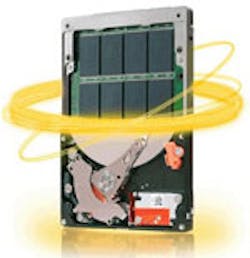The Momentus XT combines flash and hard drive
Adaptive Memory technology starts to stabilize after 3 iterations
I finally got my hands on Seagate's new Momentus XT hybrid hard drive. At 7200 RPM and half a terabyte, the Momentus XT (Fig. 1) is a great laptop drive and a good option for a desktop system as well. This also makes it an option for embedded applications as well. I am pairing the Momentus XT with Intel's high end, hex core Core i7-970. Some may prefer a large, 3.5-in drive with 2 or 3 terabytes but I think the smaller 2.5-in drive brings a lot to the desktop even though gets lost in a tower case with its diminutive size.
In a nutshell, the Momentus XT hits the mark and a faster processor actually seems to take a better advantage of the drive. The Adaptive Memory technology utilizes the 32 Mbyte cache and 4 Gigabyte SLC NAND flash. The cache is alway used but the NAND flash is employed more judiciously. Adaptive Memory only puts data into flash after it has been read repeatedly. It also takes into account the read sequence since the hard drive is no slouch once the head is over the data. The trick is to store enough data in flash to let the hard drive catch up.
Benchmarking the Momentus XT is actually a challenge because its caching mechanism is hidden from the user. It is possible to repeat a boot or application use until the performance results stabilize but it does take some time before the benifits are noticable. Once they are, the advantage remains until there is a change in usage.
In general, the Momentus XT advantage shows up when the same process is used on a regular basis. For example, booting the operating system and then running one of half a dozen programs works best. It takes about four tries to stabilize although performance differences are noticably the second time around.
I tend to run dual boot systems and this installation was no exception. Switching between operating systems has a noticable affect on the caching system. As expected, performance improvements are noticable when the same operating system is used each time the system is booted. Alternately switching between operating systems essentially reverts the drive to a normal hard drive.
The other scenario that I find more common for my desktop systems is running one operating system for a long period of time. In this case, the advantage will come into play when running one of a small set of applications regularly. It is also much harder to determine the affect of the drive because other factors come into play such as whether runtime support for an application may already be loaed because of another active application.
In this instance I can say that the drive is at least as good as a plain hard drive. In general, the system seems snappier when it needs to access the hard drive for loading an application but this is more of an anecdotal feeling than a benchmark result.
I have tried a combination of dedicated flash drive and a separate hard drive usually for data storage. Performancewise, this combination seems on par with the Momentus XT after it has stabilized. The Momentus XT is definitely easier to confiugure and use and it is also less expensive.
For a laptop, the advantages of the Momentus XT are obvious. I would say the same for desktops as well. Unfortunately, it will be more difficult to justify the use of the Momentus XT in an embedded application that does not mimic either of these environments. Applications that fit in flash alone can ignore the hybrid drive but those that do not should consider this type of drive especially if there is a regular usage cycle. In this case, benchmarking a specific application environment should be managable. Another issue to consider will be system burn-in and testing since it would be posssible to deliver hardware where the Momentus XT has already been primed.
About the Author
William G. Wong
Senior Content Director - Electronic Design and Microwaves & RF
I am Editor of Electronic Design focusing on embedded, software, and systems. As Senior Content Director, I also manage Microwaves & RF and I work with a great team of editors to provide engineers, programmers, developers and technical managers with interesting and useful articles and videos on a regular basis. Check out our free newsletters to see the latest content.
You can send press releases for new products for possible coverage on the website. I am also interested in receiving contributed articles for publishing on our website. Use our template and send to me along with a signed release form.
Check out my blog, AltEmbedded on Electronic Design, as well as his latest articles on this site that are listed below.
You can visit my social media via these links:
- AltEmbedded on Electronic Design
- Bill Wong on Facebook
- @AltEmbedded on Twitter
- Bill Wong on LinkedIn
I earned a Bachelor of Electrical Engineering at the Georgia Institute of Technology and a Masters in Computer Science from Rutgers University. I still do a bit of programming using everything from C and C++ to Rust and Ada/SPARK. I do a bit of PHP programming for Drupal websites. I have posted a few Drupal modules.
I still get a hand on software and electronic hardware. Some of this can be found on our Kit Close-Up video series. You can also see me on many of our TechXchange Talk videos. I am interested in a range of projects from robotics to artificial intelligence.

